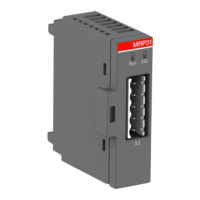Protection functions can be either on or off. If switched on, they can trigger a protection trip or a warning (excluding the thermal
overload which is always active and triggers a trip). For some functions an optional delay can be specified. Some protection func-
tions are only active after motor start-up while others are active during motor start.
Below is an overview of the available protection functions and when they are active. For details see the following sections.
Protection Function current When active Available Options:
Trip/Warning/Off
Automatic Fault
Reset Possible
Delay
Electronic Overload Always Trip Yes -
Electronic Overload
Prewarning
Always Warning - -
Locked Rotor During motor start - x
High Current After motor start Trip/Warning/OFF
separate warning and trip levels
optional delay
- x
Low Current After motor start Trip/Warning/OFF
separate warning and trip levels
optional delay
- x
Imbalance
of I
e
and all three phases
available)
Trip/Warning/OFF
(OFF = only together with phase
loss) separate warning and trip
levels
Yes Depending on trip class
Phase Loss Protection
of Ie)
Trip, Off - Depending on trip class
PTC Protection Always Trip, Warning, Off Yes after cooling
(excluding PTC wire
break and short
circuit)
-
Earth Fault Protection Always
After start-up
warning and trip levels
- x
Load Shedding / Voltage Dip Always
Not in testposition
See subsection voltage Dip -
Phase Sequence Protection Always Trip, Warning, OFF - Depending on trip class
Class 10 -> 3 s , class 20 -> 6 s, class 30 -> 9 s, class 40 -> 12 s) is over. The class time begins with the start command.
The motor-related and protection-related parameters shall be set according to the motor manufacturer's data sheet. Other para-
meters of the UMC shall be carefully selected based on the process and the system requirements.
37

